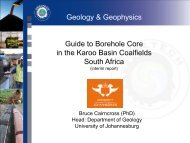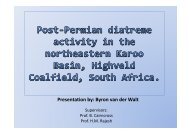coaltech upper olifants river catchment wetland inventory ...
coaltech upper olifants river catchment wetland inventory ...
coaltech upper olifants river catchment wetland inventory ...
You also want an ePaper? Increase the reach of your titles
YUMPU automatically turns print PDFs into web optimized ePapers that Google loves.
Table 1: Species of concern<br />
Species name Common name<br />
Birds<br />
Phoenicopterus<br />
ruber<br />
Alcedo<br />
semitorquata<br />
Greater<br />
Flamingo NT Y<br />
Wetland Database for UORC - 19 -<br />
Red<br />
Data Protected Wetland type Habitat<br />
Non-perennial Pans,<br />
Perennial Pans<br />
Halfcollared<br />
Kingfisher NT Non-floodplain riparian<br />
Large bodies of shallow water, inland and coastal;<br />
saline and brackish waters preferred. Occasionally<br />
forages along sandy coasts. Usually breeds<br />
colonially on mudflats in large pans.<br />
Fast-flowing perennial streams, <strong>river</strong>s and estuaries,<br />
usually with dense marginal vegetation. Usually<br />
perches low down on the banks of streams, often on<br />
exposed roots. Requires <strong>river</strong>banks in which to<br />
excavate nest tunnels.<br />
Midland and highland grassveld, edge of karoo,<br />
cultivated land and edges of vleis. Nests in both<br />
moist situations in vleis which have short grass<br />
cover and in dry sites far from water, usually<br />
exposed places such as on hillsides; forages in<br />
grassland, cultivated and fallow lands; roosts<br />
communally in the shallow water of pans and dams.<br />
Possible distribution<br />
Entire <strong>catchment</strong><br />
Anthropoides<br />
Floodplain riparian, Nonfloodplain<br />
riparian,<br />
Seepage Non-perennial<br />
Pans, Perennial Pans,<br />
paradiseus Blue Crane V Y<br />
Artificial <strong>wetland</strong>s<br />
Yellow-breasted<br />
Eastern portion of the<br />
Anthus chloris Pipit V Seepage Undulating grasslands<br />
<strong>catchment</strong><br />
Floodplain riparian, Non- Lowland swamps and densely vegetated swamps Gauteng Province<br />
Botaurus stellaris Eurasian Bittern Cr En<br />
floodplain riparian<br />
with tall vegetation<br />
Bugeranus<br />
Floodplain riparian, Non-<br />
Rare over the entire<br />
carunculatus Wattled Crane Cr En<br />
floodplain riparian Permanent <strong>wetland</strong>s, opportunistically seasonal<br />
Feeds in and around marshes, dams, <strong>river</strong>s and<br />
<strong>catchment</strong><br />
Floodplain riparian, Non- estuaries; breeds in mountainous regions. Feeds<br />
floodplain riparian, Artificial mainly on fish and is therefore uncommon at<br />
Ciconia nigra Black Stork NT Y<br />
<strong>wetland</strong>s<br />
seasonal pans lacking fish. It nests on cliffs.<br />
Wetlands and surrounding grasslands. Most<br />
highveld <strong>wetland</strong>s > 100ha support a breeding pair.<br />
Nests in extensive reedbeds often high above water.<br />
Forage over reeds, lake margins, floodplains and<br />
Entire <strong>catchment</strong><br />
African March-<br />
occasionally even woodland. Almost entirely absent<br />
Circus ranivorus Harrier V Y Floodplain riparian<br />
from areas below 300mm of rainfall.<br />
Forage preferentially in pristine grassland. They<br />
roost communally in tall trees, mainly Eucalyptus, in<br />
urban areas. Open grassland and intensively<br />
cultivated agricultural areas under maize, sorghum,<br />
peanuts, wheat, beans and other crops. Typical of<br />
Entire <strong>catchment</strong><br />
Falco naumanni Lesser Kestrel V Y Seepage<br />
semi-arid grasslands, avoiding wooded areas.<br />
Cliffs, mountains, steep gorges, sometimes open<br />
Falco peregrinus Peregrine Falcon NT Non-floodplain riparian grassland and rarely cities




